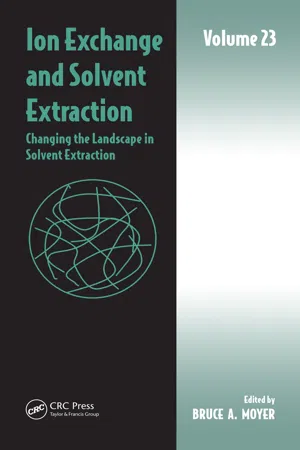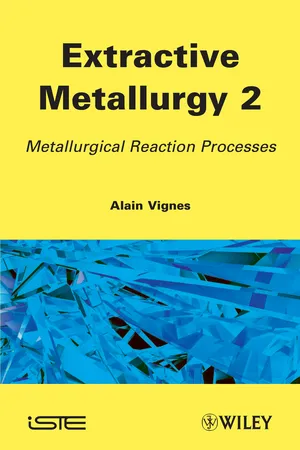Chemistry
Extracting Metals
Extracting metals involves obtaining pure metals from their ores through various processes such as reduction, electrolysis, and smelting. These methods typically involve removing impurities and separating the metal from its ore using chemical reactions and physical processes. The choice of extraction method depends on factors such as the reactivity of the metal and the stability of its compounds.
Written by Perlego with AI-assistance
Related key terms
Related key terms
1 of 4
Related key terms
1 of 3
3 Key excerpts on "Extracting Metals"
- eBook - ePub
- Sir Alan Cottrell(Author)
- 2019(Publication Date)
- CRC Press(Publisher)
Chapter 8Extraction of Metals
8.1 Metallic ores
We saw in § 2.6 that many of the familiar metals occur sparsely in the earth’s crust. Fortunately, geological processes have partly concentrated them in workable ore deposits. The value of a mineral ore has, of course, to be judged against the general demand and availability of the metal and of alternative sources of supply as well as on characteristics of the ore itself, such as the chemical state of the metal, nature and content of impurities, physical state of the mineral and accessibility of the deposit. For example, a deposit containing less than 20 per cent Fe has little value as an iron ore since there are many with 30–50 per cent Fe and a few with 70 per cent, but one containing 4 per cent Cu is a good copper ore.Table 8.1 gives the world production and prices of metals. These values are very approximate and subject to wide fluctuations, but they indicate the very large differences that exist. The choice of extraction processes has to be judged in the light of these economic factors. The elaborate chemical solvent treatments used, for example, in the extraction of beryllium would be prohibitively expensive for metals such as iron or lead, where cheap bulk methods have to be used.TABLE 8.1. APPROXIMATE ANNUAL WORLD OUTPUT OF METALS AND UNITED KINGDOM PRICES, 1972We saw in § 2.6 that there is plenty of oxygen on earth to form oxides. However, at the very high temperatures at which the earth is presumed to have formed, most metals would have been chemically uncombined. The heavier metals, particularly much of the iron, would then have been pulled by gravity to the centre, so forming a metallic core about 4000 miles across. At the lower temperatures reached in the surrounding envelope of mainly light elements (O, Si, Al) a semi-molten magma of silica and silicates formed, about 2000 miles thick, and near the surface crystallized into the solid crust. This is about 30 miles deep, although much thinner underneath the oceans, and consists mainly of an upper layer of granite (Al and Ca silicates) and a lower layer of basalt (Mg and Fe silicates). The mantle beneath the crust consists mainly of olivine (Mg and Fe silicates) and other mixed silicates such as garnet - eBook - ePub
Ion Exchange and Solvent Extraction
Volume 23, Changing the Landscape in Solvent Extraction
- Bruce A Moyer(Author)
- 2019(Publication Date)
- CRC Press(Publisher)
1 New Insights into the Recovery of Strategic and Critical Metals by Solvent ExtractionThe Effects of Chemistry and the Process on Performance
Jason B. Love , Manuel Miguirditchian , and Alexandre Chagnes
CONTENTS 1.1 Introduction 1.2 Extractant Design 1.2.1 The Role of Coordination Chemistry and Supramolecular Chemistry on the Design of New Extractants 1.2.1.1 Complex Formation 1.2.1.2 Ion Pairs and Metalates 1.2.1.3 Reverse Micelles 1.2.1.4 Conclusion 1.2.2 The Role of Physicochemistry for a Rational Design of New Extractants 1.2.3 Case Studies 1.2.3.1 Design of New Extractants for Uranium Recovery from Wet Phosphoric Acid 1.2.3.2 Chemical Design in Gold Recovery by Urban Mining 1.3 Flowsheet Optimization 1.3.1 Effect of Flowrates on Flowsheet Performances 1.3.2 Influence of Degradation on Flowsheet Performance 1.3.3 Combining Chemistry and Engineering for Flowsheet Optimization 1.3.4 Perspective in the Development of Tools for Flowsheet Optimization 1.4 Conclusion References1.1 Introduction
The exploitation of nonthermal chemical separation processes, which would lower global energy use, emissions, and pollution, is particularly pertinent to the recovery of metals from their primary ores and secondary resources [1 ]. In principle, the separation of metals by hydrometallurgical processes such as solvent extraction (SX, Figure 1.1 ) can achieve these outcomes due to ambient-temperature operation and the maintenance of materials balance through reagent recycling [2 ]. However, significant challenges remain, not least with attaining high levels of separation between metals, but also with issues such as reagent stability, complexity, cost, safety, and recyclability [3 ,4 ].FIGURE 1.1 - eBook - ePub
Extractive Metallurgy 2
Metallurgical Reaction Processes
- Alain Vignes(Author)
- 2013(Publication Date)
- Wiley-ISTE(Publisher)
Chapter 1Hydrometallurgical Extraction Processes
1.1. Overview of hydrometallurgical processes
Hydrometallurgical processing routes of ores, concentrates, residues and wastes consists of a sequence (or combination) of unit operations where physical or chemical unit processes are performed:– physical processes, called separation processes , include: flotation, filtration and distillation (these are studied in [VIG 11c], Chapter 1 );– chemical processes include: leaching (dissolution), precipitation and solvent extraction (SX);– electrochemical processes include: electrowinning of an electrolytic purified solution in order to obtain the pure metal; electro-dissolution of mattes; and electro-dissolution of impure metals (electrorefining ) (these processes are studied in Chapter 2 ).The sequence of leaching, separation (by precipitation or solvent extraction) and/or electrometallurgy is general.This chapter deals with the extraction processes that occur in hydrometallurgical unit operations and with the hydrometallurgical processing routes (illustrated by flow sheets) of oxide ores, sulfide concentrates and mattes.The leaching operation of an ore or concentrate with an aqueous lixiviant solution is widely used in metal recovery from ores or concentrates, since many oxides or sulfides form soluble salts in aqueous media. It produces partial or complete dissolution of the components of an ore/concentrate in the aqueous solution. In thecase of partial dissolution, a filtration or decantation of the solid residue allows the dissolved components to be separated from the non-dissolved. In the case of components’ total dissolution, the separation of the leaching products will then be performed, either by solvent extraction or by selective precipitation. In some operations, dissolution of a constituent (component) occurs simultaneously with the precipitation of another component. This operation will then be followed by filtration of the precipitate.
Index pages curate the most relevant extracts from our library of academic textbooks. They’ve been created using an in-house natural language model (NLM), each adding context and meaning to key research topics.
Explore more topic indexes
Explore more topic indexes
1 of 6
Explore more topic indexes
1 of 4


